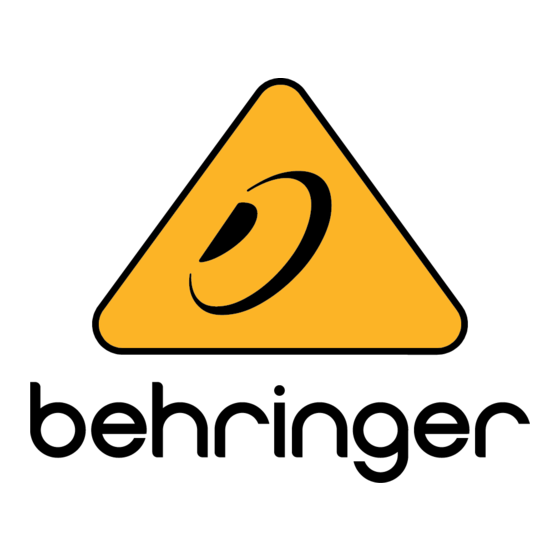
Publicidad
Tabla de contenido
Quick Start Guide
112 DUAL VCO
Legendary Analog Dual VCO
Module for Eurorack
Controls
(EN)
(1)
(2)
(3)
(4)
(5)
(6)
(7)
(8)
(9)
(10)
(11)
(12)
PW MOD IN - Accepts a voltage from another module
(1)
to control the pulse width.
VCO OUT - Send the VCO signal to one or two sources
(2)
via 3.5 mm TS cables.
WAVEFORM - Select pulse, triangle or sawtooth
(3)
waveforms for the VCO.
PULSE WIDTH - Adjusts the pulse width modulation
(4)
based on the voltage received at the PW MOD IN jack.
MOD MANUAL - Sets the ratio between the upper
(5)
and lower portions of the pulse wave.
SYNC OUT - Sends a synchronization signal
(6)
via 3.5 mm TS cable.
RANGE - Sets the pitch range of the VCO in octave steps.
(7)
SYNC IN - Accepts a synchronization signal
(8)
via 3.5 mm TS cable.
WEAK/STRONG - Determines the accuracy
(9)
of synchronization.
PITCH - Fine tunes the pitch.
(10)
V 1.0
MOD LEVEL - Adjusts the level of the signal connected
(11)
to the associated MOD IN jack.
MOD IN - Accepts voltages that control or modulate
(12)
the VCO pitch.
Power Connection
The module comes with the required power cable for connecting
to a standard Eurorack power supply system. Follow these
steps to connect power to the module. It is easier to make these
connections before the module has been mounted into a rack case.
1.
Turn the power supply or rack case power off and
disconnect the power cable.
2.
Insert the 16-pin connector on the power cable into the
socket on the power supply or rack case. The connector has
a tab that will align with the gap in the socket, so it cannot
be inserted incorrectly. If the power supply does not have
a keyed socket, be sure to orient pin 1 (-12 V) with the red
stripe on the cable.
3.
Insert the 10-pin connector into the socket on the back of
the module. The connector has a tab that will align with the
socket for correct orientation.
4.
After both ends of the power cable have been securely
attached, you may mount the module in a case and turn on
the power supply.
Installation
The necessary screws are included with the module for mounting in a
Eurorack case. Connect the power cable before mounting.
Depending on the rack case, there may be a series of fixed holes spaced
2 HP apart along the length of the case, or a track that allows individual
threaded plates to slide along the length of the case. The free-moving
threaded plates allow precise positioning of the module, but each plate
should be positioned in the approximate relation to the mounting
holes in your module before attaching the screws.
Hold the module against the Eurorack rails so that each of the
mounting holes are aligned with a threaded rail or threaded
plate. Attach the screws part way to start, which will allow small
adjustments to the positioning while you get them all aligned. After
the final position has been established, tighten the screws down.
Publicidad
Tabla de contenido

Resumen de contenidos para Behringer 112 DUAL VCO
- Página 1 Quick Start Guide 112 DUAL VCO MOD LEVEL - Adjusts the level of the signal connected (11) to the associated MOD IN jack. Legendary Analog Dual VCO MOD IN - Accepts voltages that control or modulate (12) Module for Eurorack the VCO pitch.
-
Página 2: Instalación
112 DUAL VCO Quick Start Guide Conexión Eléctrica Connexion Électrique Controles Réglages (ES) (FR) Le module est livré avec le câble d’alimentation requis pour la El módulo viene con el cable de alimentación necesario para connexion à un système d’alimentation standard Eurorack. Suivez conectarse a un sistema de suministro de energía Eurorack estándar. - Página 3 112 DUAL VCO Quick Start Guide Netzanschluss Conexão de Força Bedienelemente Controles (DE) (PT) Das Modul wird mit dem erforderlichen Stromkabel für den O módulo vem com o cabo de alimentação necessário para Anschluss an ein Standard-Eurorack-Stromversorgungssystem conectar a um sistema de fonte de alimentação Eurorack padrão.
-
Página 4: Installatie
112 DUAL VCO Quick Start Guide Connessione di Alimentazione Stroomaansluiting Controlli Bediening (IT) (NL) Il modulo viene fornito con il cavo di alimentazione necessario per De module wordt geleverd met de benodigde voedingskabel il collegamento a un sistema di alimentazione Eurorack standard. - Página 5 112 DUAL VCO Quick Start Guide Strömanslutning Podłączenie zasilania Kontroller Sterownica (SE) (PL) Modulen levereras med den strömkabel som krävs för att Do modułu dołączony jest wymagany kabel zasilający do ansluta till ett vanligt Eurorack-nätaggregat. Följ dessa steg podłączenia do standardowego systemu zasilania Eurorack.
- Página 6 112 DUAL VCO Quick Start Guide Specifications Pulse Width Input Controls Type 2 x 3.5 mm TS jacks, PW level -∞ to unity gain DC coupled PW manual 50% to min Impedance 70 kΩ, unbalanced Waveform Triangle, sawtooth, pulse Maximum input level ±10 V, 4% per volt...
- Página 7 Midas, Klark Teknik, zijn eigendom van hun respectievelijke eigenaren. Midas, Klark Teknik, TC Electronic, TC Helicon, Behringer, Bugera, Oberheim, Auratone, propriétaires respectifs. Midas, Klark Teknik, Lab Gruppen, Lake, Lab Gruppen, Lake, Tannoy, Turbosound, TC Electronic, TC Helicon,...
-
Página 8: Zastrzeżenia Prawne
Wszystkie znaki towarowe są własnością ich odpowiednich właścicieli. Midas, Klark Teknik, Lab Gruppen, Lake, Tannoy, Turbosound, TC Electronic, TC Helicon, Behringer, Bugera, Oberheim, Auratone, Aston Microphones i Coolaudio są znakami towarowymi lub zastrzeżonymi znakami towarowymi firmy Music Tribe Global Brands Ltd. - Página 9 We Hear You...









